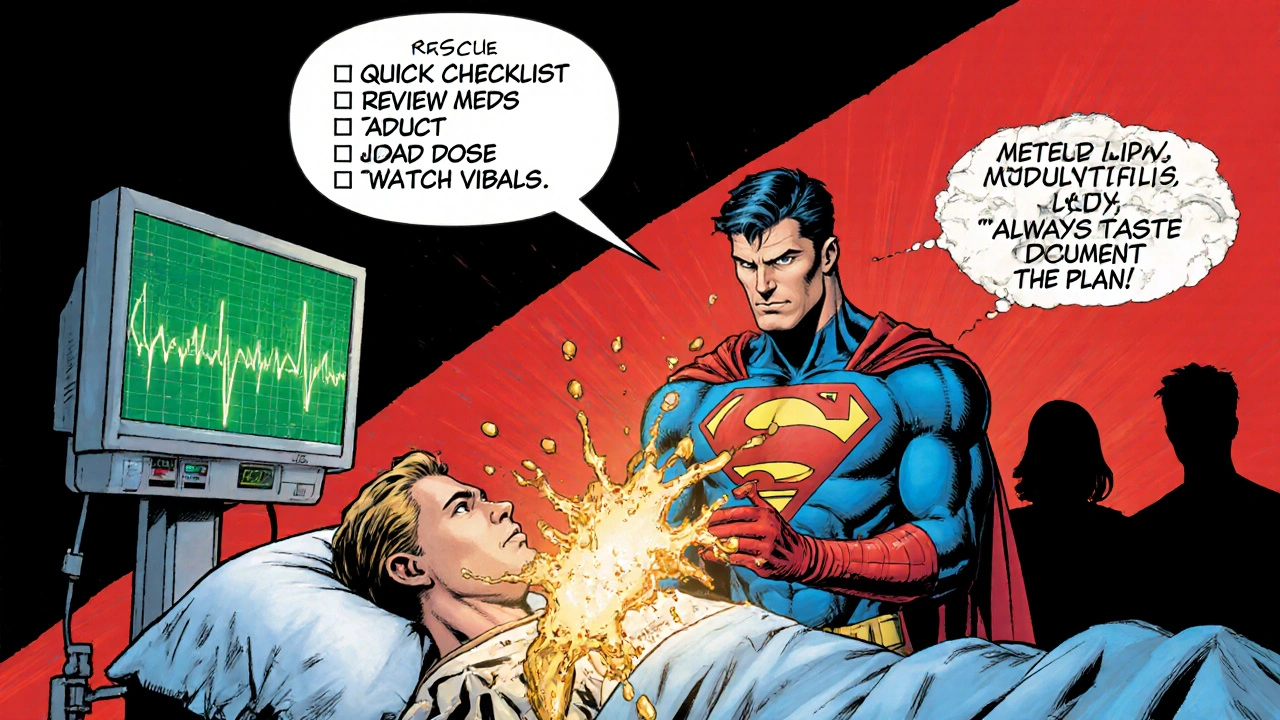Lidocaine Drug Interaction Checker
Lidocaine Interaction Assessment
Check potential interactions between lidocaine and other medications. This tool identifies interactions based on pharmacokinetic and pharmacodynamic mechanisms.
Interaction Results
Management Recommendations
When you hear the name Lidocaine is a medium‑acting local anesthetic that works by blocking sodium channels in nerve membranes. It’s used for everything from dental procedures to cardiac arrhythmia treatment, and it shows up in many emergency kits. Because lidocaine is cleared by the liver, it can clash with a surprising number of other medicines. Understanding those clashes can prevent toxicity, keep heart rhythms stable, and avoid unnecessary pain.
Key Takeaways
- Lidocaine is mainly metabolised by CYP3A4 and CYP2D6 enzymes.
- Drugs that inhibit these enzymes (e.g., amiodarone, cimetidine) raise lidocaine levels and increase toxicity risk.
- Concurrent use with beta‑blockers, calcium‑channel blockers, or epinephrine can amplify cardiac effects.
- Adjust the dose or monitor serum concentrations when high‑risk combinations are unavoidable.
- Always check the patient’s medication list before administering lidocaine.
How Lidocaine Works
The anesthetic effect comes from lidocaine’s ability to bind the intracellular portion of the sodium channel protein, preventing the influx of Na⁺ ions that generate an action potential. When the nerve can’t fire, the brain never receives the pain signal. In cardiac tissue, the same blockade slows conduction, which is why lidocaine can also serve as an anti‑arrhythmic (ClassIb).
Metabolism Pathways
Lidocaine is processed almost entirely in the liver. The primary routes are oxidation by the cytochrome P450 family-especially CYP3A4 and, to a lesser extent, CYP2D6. The metabolites are then conjugated and excreted in urine. Anything that slows these enzymes will cause lidocaine to linger longer, raising both the peak concentration and the risk of central nervous system (CNS) or cardiac toxicity.
Common Drugs That Interact with Lidocaine
Below are the most frequently encountered medicines that can change how lidocaine behaves. The table that follows groups them by the type of interaction and gives practical tips.
| Drug | Interaction Type | Clinical Impact | Management |
|---|---|---|---|
| Amiodarone | Enzyme inhibition (CYP3A4) | ↑ Lidocaine plasma levels; risk of seizures, bradycardia | Reduce lidocaine dose by 30‑50% or monitor serum levels. |
| Propranolol (beta‑blocker) | Pharmacodynamic synergy | Excessive cardiac depression when both lower heart rate. | Watch HR and blood pressure; avoid high‑dose IV lidocaine. |
| Verapamil | Calcium‑channel blockade + CYP3A4 inhibition | Marked hypotension, AV block. | Administer lidocaine slowly; consider dose reduction. |
| Epinephrine (vasoconstrictor) | Pharmacodynamic interaction | Prolonged lidocaine effect; potential for local tissue ischemia. | Use recommended epinephrine concentration (1:100,000) and limit total lidocaine volume. |
| Cimetidine | Broad CYP inhibition | Elevated lidocaine levels, especially in elderly. | Consider alternative H2 blocker or lower lidocaine dose. |

Mechanisms Behind the Interactions
There are three big ways other meds mess with lidocaine:
- Enzyme inhibition: Drugs like amiodarone or cimetidine bind to CYP3A4, slowing the conversion of lidocaine to inactive metabolites. The result is a higher plasma concentration for longer.
- Pharmacodynamic synergy: Beta‑blockers, calcium‑channel blockers, and epinephrine affect the heart’s electrical activity. When lidocaine’s own anti‑arrhythmic action is added, the combined effect can tip the patient into bradyarrhythmias or severe hypotension.
- Altered distribution: Epinephrine causes local vasoconstriction, which keeps lidocaine at the injection site longer. That’s useful for prolonged numbness, but it also raises the chance of local tissue toxicity if the dose is too high.
Practical Strategies to Minimize Risk
- Take a full medication history: Ask about prescription drugs, over‑the‑counter meds, and herbal supplements that might hit CYP3A4.
- Adjust the dose: For strong CYP inhibitors, cut the lidocaine dose by at least a third. Many anesthesiologists start with 1mg/kg instead of the usual 1.5mg/kg.
- Use serum level monitoring when available, especially in patients with liver disease or when using continuous infusions.
- Space out administrations: If the patient needs both a beta‑blocker and lidocaine, give the lidocaine first, then wait 15‑30minutes before the beta‑blocker to see how the heart reacts.
- Educate patients: Tell them to report tingling, metallic taste, or unusual dizziness-early signs of lidocaine toxicity.
Quick Checklist for Clinicians
- Review all current meds for CYP3A4/CYP2D6 inhibitors.
- Identify any cardiac‑active drugs (beta‑blockers, verapamil, digoxin).
- Decide on dose reduction - typically 30‑50% for strong inhibitors.
- Plan monitoring: ECG, pulse oximetry, and if possible, lidocaine serum level.
- Document the interaction plan in the patient chart.

Special Populations
Elderly patients often have reduced hepatic blood flow, making them more prone to accumulation. Even mild inhibitors can push lidocaine into the toxic range.
Pediatric cases require weight‑based dosing, and many CYP enzymes are not fully mature. Use caution with concurrent anticonvulsants that may also affect metabolism.
Patients with liver disease (e.g., cirrhosis) need a baseline dose reduction of at least 25% and close observation for CNS signs (e.g., slurred speech, visual disturbances).
What to Do If Toxicity Occurs
Early detection is key. Watch for the classic triad: circumoral numbness, tinnitus, and a metallic taste. If you see any of these, stop the infusion or stop further injections immediately.
- Support airway and breathing-administer oxygen.
- Treat seizures with benzodiazepines (e.g., lorazepam).
- For severe cardiac depression, consider intravenous lipid emulsion therapy-an established antidote for local anesthetic systemic toxicity (LAST).
After stabilising the patient, reassess the medication regimen and adjust future lidocaine plans accordingly.
Frequently Asked Questions
Can I use over‑the‑counter pain relievers with lidocaine?
Most NSAIDs (ibuprofen, naproxen) don’t affect lidocaine metabolism, so they’re generally safe. However, avoid combining with other local anesthetics or strong CYP inhibitors without dose adjustment.
Is it safe to take herbal supplements like St.John’s wort?
St.John’s wort induces CYP3A4, which can actually lower lidocaine levels, potentially reducing its effectiveness. Discuss any supplements with your clinician.
Why do some dentists add epinephrine to lidocaine?
Epinephrine constricts blood vessels, keeping lidocaine localized for longer and reducing bleeding. The trade‑off is a higher chance of cardiovascular side‑effects, especially in patients with heart disease.
What serum level of lidocaine is considered toxic?
Levels above 5µg/mL are generally associated with CNS toxicity; cardiac toxicity tends to appear when concentrations exceed 8‑10µg/mL. Exact thresholds vary with patient factors.
How long does it take for lidocaine interactions to resolve after stopping the offending drug?
Because lidocaine’s half‑life is about 1.5-2hours in healthy adults, most interactions wane within 6-8hours after the inhibitor is cleared. In liver disease, the clearance can double that time.
Knowing the most common lidocaine drug interactions allows clinicians to tailor dosing, monitor safely, and avoid serious adverse events. Keep this guide handy the next time you’re about to inject or infuse lidocaine-you’ll be better prepared to protect your patients.

Roger Perez
October 15, 2025 AT 18:10